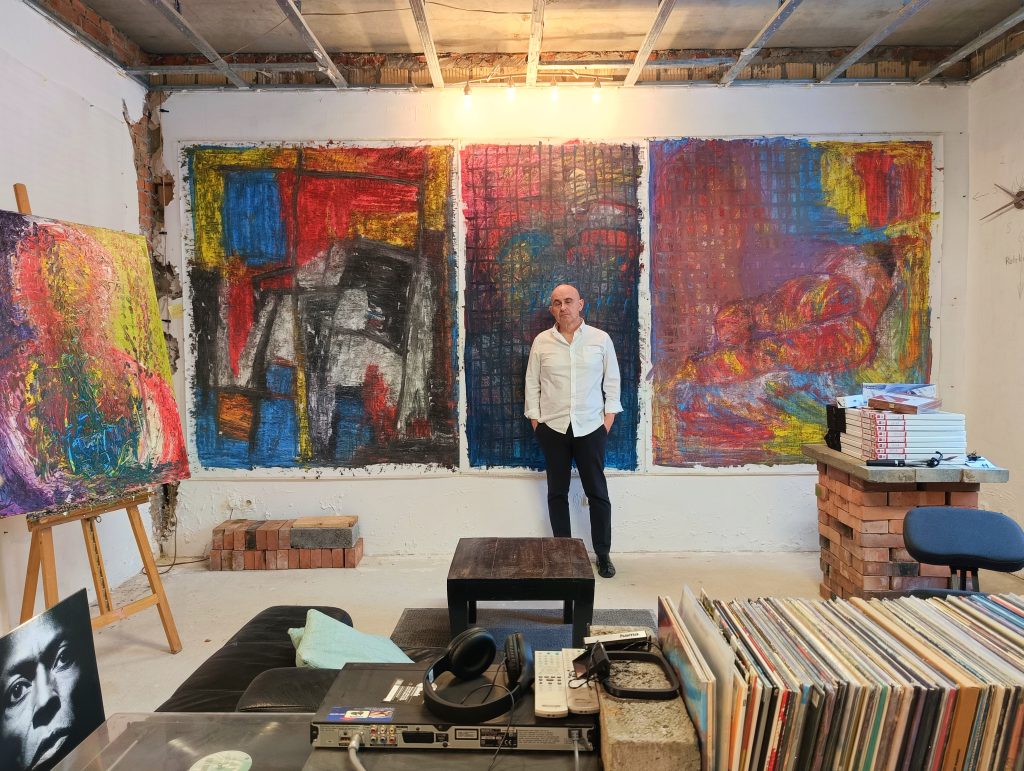Passing through the contour, beyond the ego
In Orapism, Ination is a moment of breakthrough – not when the artist begins to paint, but when painting begins to happen without the artist. This is a phase without which one cannot speak of a true act of Orapism – because it is precisely then that the “I” disappears and presence appears.
The process begins with the conscious action of the ego. The Orapist sketches in pencil – the forms are thought out, the structure is foreseen. Then the ego strengthens its presence, correcting the sketch with black ink. This is the moment of declaration: “this is my plan, my order, my form”.
And it is precisely when the surface is taken over by the order of the ego – that a crack occurs.
The Orapist applies oil paint with a spatula. Initially, this may be in accordance with the composition. But at some point – often unexpectedly – the gesture escapes control. The paint passes through the black contour. This crossing is not intentional. It is a coincidence. It is a revelation.
It is at this moment that the Ination begins. The ego is surprised – its map is violated. For a split second it does not know what to do. And if the Orapist does not correct, does not step back, does not start to “save the composition” – then there is a transition beyond the form.
At this moment the hand continues to act, but no longer from the level of the person. The spatula spreads the color, mixes the structures, tears the space. Then the gesture of the stylus appears – a sharp tool that scratches the surface covered with paint. This gesture is not decoration. It is like cutting the film – as if one wanted to reach deeper than the color, than the texture.
In the language of experience:
- cutting the contour with paint is the moment when the form of the ego loses power.
- cutting the paint with the stylus is a gesture in which the Orapist tries to unseal the surface of reality.
This is not the destruction of the painting – it is a transformational event.
Ination is not a moment of stillness. It is a silence full of movement that begins to lead. The Orapist remains in the gesture – but it is no longer he who paints. It is presence that paints through it. Each subsequent trace – a blur, a scratch, a cut – is a register of transition. Transition from the “I” to pure presence in action.
Externally, it may look like dynamic, even violent work – but internally there is silence. No narrative. No evaluation. No plan. There is only movement through existence.
Until the moment comes when something ends. The body stops by itself. The consciousness of the person returns. The ego returns – often quietly, sometimes with tension – but already different. Because something happened. Something was painted.
Only the image passing through Ination is Orapism
Everything that was created earlier – a plan, a sketch, ink – is preparation. Only the paint going beyond the outline triggers the transition. If the ego is not surprised, the image will remain only a composition. But if the outline is crossed – and the creator does not stop the gesture – then something else appears on the canvas: a trace of presence without a person.
This is not a style. This is not a technique.
This is the moment when the Orapist disappears.
And that is why Ination is the heart of Orapism.
